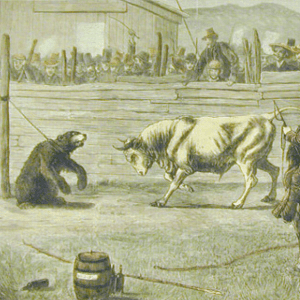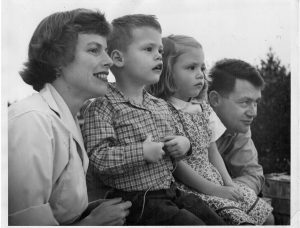July 13, 2018
The exterior stainless steel cable has been installed around the center of the adobe building, concluding the seismic work at the site. The cable connects to the interior floor joists by way of a bracket and eye bolt. The cable is then threaded through the eye bolt and is anchored into the wall.
Plaster contractor Chris Ingram Lath & Plaster, use lime plaster to fill in the void and metal mesh is then installed. Eventually the wall will be whitewashed to conceal the cable install area. With the install of the cable, all of the seismic work is officially done at the Castro Adobe!

The crew carefully works on installing the cable and filling in the void.

Mesh is installed over the cable.

Mesh installed on the west side of the building.

Cable infill is complete.
March 30, 2018
The first steps to restoring the interior of the Castro Adobe began when the stucco netting (stucco and chicken wire), which had encased the historic adobe walls since the 1960s, was carefully removed. The removal of the stucco netting exposed the historic walls and finishes, a bit of additional historic graffiti, and evidence of an original shelf in the northeast wall of Room 104.

Contractor Brian Bogaard and his assistant remove the stucco netting from the west wall.

An original shelf, which had been demolished to accommodate the application of the stucco netting, was exposed. This corner shelf will be restored.

Northeast corner before removal of stucco netting.
March 1, 2018
Contractor Brian Bogaard has completed construction on the railing and exterior stairs of the Castro Adobe. This is an exciting step forward to improve safe access to this historic structure. Check out the photos of the progress.

The balcony decking under construction. Stairs and railing haven’t been constructed at this point. View facing north.

The exterior stairs under construction. A wood partition will eventually enclose the exterior stairs at the bottom.

Contractor Brian Bogaard works on the construction of the railing on the façade of the Castro Adobe.

The balcony decking, railing and stairs complete. This is the view facing north.
November 30, 2017
 KCBS reporter Matt Bigler recently visited the Castro Adobe to learn about the history of bull and bear fights at the property after recent archaeological work at the Castro Adobe unearthed what appeared to be the remains of a bull and bear fight pit.
KCBS reporter Matt Bigler recently visited the Castro Adobe to learn about the history of bull and bear fights at the property after recent archaeological work at the Castro Adobe unearthed what appeared to be the remains of a bull and bear fight pit.
Listen to the story.
Times were very different during the Mexican Rancho period of the 1821-1850. The Spanish brought with them the tradition of bull fighting. The grizzly bear roamed freely in California at that time and skilled vaqueros (cowboys) would ride and capture a bear with their reata (lasso) and bring the captured animal back to where the fight was to be held.
Prior to the mid-1860s, the spectacle of brutal bear and bull fights were enjoyed on the Sabbath after church services. Fights were held at Whisky Hill near Watsonville, in Santa Cruz at the junction of Branciforte Creek and San Lorenzo River (San Lorenzo Park) and at the Castro Adobe.
It took four or five vaqueros on their horses to go out and capture a grizzly bear. They had to lasso the grizzly’s neck and legs, and coerce the animal into walking many miles back to the mission or rancho. One description states that “one unattached vaquero might actually ride in front of the grizzly and tease him into charging, which was not hard to do, and the longer the charge, the more ground was gained.”
Once at the Castro Adobe, bull and bear fights were held in the front of the adobe building, probably in a corral or designated fighting ring. Women and children would sit up on the balcony and watch while the men were closer to the action. When the two animals fought each other, people would bet on which one would survive or be killed.
In 1854, a state law was introduced to “provide better observance of the Sabbath.” Bear and bull fighting were banned, but after the law was passed it was not strictly enforced. It is not clear when the last bull and bear fight took place in Santa Cruz County but in the 1870s, they were considered “disgraceful exhibitions, cruel sports and barbarous amusements.”
At the Castro Adobe, a reminder of the bull and bear fights was in place until the late 1950s when a hand wrought iron ring and tang was found inserted into a dying oak tree near the front of the building. It was used to tie up one of the animals during the fight. Times have changed at the Castro Adobe and bull and bear fighting today would be considered a crime. We can use historical accounts detailing the bull and bear fights to show us how much the culture (and animal rights) have changed since the late 1870s.
June 7, 2017
We appreciate the generous support of Boho Castro, a Bohemian-style fundraiser for the Castro Adobe, held Saturday, June 10 at Castro Adobe State Historic Park. This event is a fundraiser to support the opening of Castro Adobe State Historic Park. The following sponsors and supporters have helped make this event possible. Thank you!

June 5, 2017
The accessible pathway in front of the cocina has just been extended to meet the beautiful, newly built redwood boardwalk.
May 9, 2017

The Jowers, Castro Adobe stewards (1963-68), owned and lived in the Castro Adobe during the Bohemian era of the 1960s. The Jowers also were the proprietors of the avante-garde Sticky Wicket restaurant in Aptos, a center for Santa Cruz County’s artistic community. The Jowers were instrumental in establishing the Cabrillo Festival of Contemporary Music and even held early fundraising events for the festival at the Castro Adobe.
Victor and Sidney Jowers led remarkable lives, part of them at the Castro Adobe. Victor – reporter, restaurateur, Londoner – and Sidney – author, costume designer, New Yorker – loved the Old Adobe, as everyone called it in the 1960s. It was Victor’s home when he died at 39; it was the home Sidney left soon after when she moved with her two children to England, there to stay. For them, the Adobe was a celebration of culture, history and family, of the arts and of life.
Join us for a Bohemian-inspired gathering to honor Castro Adobe stewards from the past and celebrate recent progress toward opening the Castro Adobe State Historic Park at Boho Castro, the fourth annual stewardship event at Castro Adobe. Get tickets.
Step back into the 1960s at the Castro Adobe, a time when the Jowers family owned and cared for the property. Relive the Jowers’ good times, when an eclectic ensemble of their artistic friends made the Castro Adobe a Bohemian center of arts and culture. We’re honored to be joined at Boho Castro by Victor and Sidney’s children, Laura and Andrew.
Stewardship Honorees to date
—2016—
Fred Webster, Castro Restoration Engineer
—2015—
Elizabeth & David Potter (1968-88)
—2014—
Edna & Joe Kimbro (1988-2001)
Jim Toney, Friends’ Board Member & Castro Volunteer
April 29, 2017

Work continues to restore the historic Castro Adobe. In April, the columns for the east façade were crafted by contractor Brian Bogaard. Sizing of the columns and cut of the chamfers were painstakingly researched to ensure they matched the original columns. Brian’s expert craftsmanship really shows on each carefully cut column. The columns have been carefully inserted and are awaiting final installation.
The next phase of work includes the beginning installation of the balcony.
March 29, 2017

Vintage photo of early vaquero c1910, a head vaquero for Miller & Lux operating in Santa Cruz & Santa Clara counties, his name was Narcisco Jesus Castro. (photograph courtesy of Frank Estrada)
From the first Spanish expedition into Alta California in 1769, the vaquero played a significant role in California’s heritage. Vaqueros, or horse-mounted livestock herders, originated on the Iberian Peninsula and were brought to the Americas from Spain. The vaqueros of the Americas were horsemen and cattle herders in Spanish Mexico who came to California. The vaquero “culture” developed into a fine art through the Mission and Rancho eras, and continued into the early 1900s.
At the Rancho San Andres Castro Adobe, herds of cattle and livestock grazed the land under the mounted vaquero’s watchful eye. The vaqueros were skilled in the use of the rawhide riata for cattle sorting, roping, branding and slaughter, as well as roping grizzlies. The rider and the horse worked in partnership with the slightest of “cues” hardly noticeable. True horsemen were held in highest regard for their patience, knowledge and skills regarding horses, cattle and the land.
Today, the history, horsemanship, equipment, knowledge of land use and lifestyle of vaqueros are revered traditions. Learn about the vaquero culture and view a demonstration of vaquero-style horsemen at Vaqueros on the Rancho, a ticketed fundraising event at Castro Adobe State Historic Park on Saturday, May 6.
March 21, 2017
Work is progressing on Phase 3 at the Castro Adobe. This work includes restoring the balcony and stairs, and installing a wood boardwalk underneath the balcony. This also includes the final piece of the seismic retrofit with the installation of the cable wrapping around the center of building.
As part of the work, the non-historic balcony, stairs, columns and pavers were removed. Taking down the balcony exposed the pockets for the original balcony floor joists which indicated that the balcony was originally cantilevered.
Work this week and next continues with the installation of a concrete slab for the boardwalk and the footings for the columns.

Contractor Brian Bogaard and the new 6 ¾ x 6 ¾ beams before installation.

New beams installed at roof.

Balcony floor removed.

Joists removed showing original joist pockets.











 KCBS reporter Matt Bigler recently visited the Castro Adobe to learn about the history of bull and bear fights at the property after recent archaeological work at the Castro Adobe unearthed what appeared to be the remains of a bull and bear fight pit.
KCBS reporter Matt Bigler recently visited the Castro Adobe to learn about the history of bull and bear fights at the property after recent archaeological work at the Castro Adobe unearthed what appeared to be the remains of a bull and bear fight pit.







